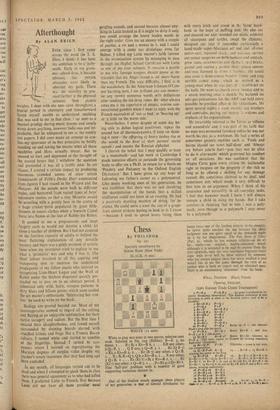Chess
By I'1111.1DOR No. 220 Specially contributed by SIMON KING (New York) IlLA(1: ;8 men i 1TE (II men)
White to play and mate in two moves; solution next week. Solution to No. 219 (Millins): B—K 3, no threat. i . . . B x B; 2 Kt—B 6. I . . . KB any other; 2 Qx R. Q B any; 2 Q—K 5. x .. Kt (Q B 7) x Kt; 2 Kt—.B 2. 1. . . Kt (B 7) any other; 2 Qx B.
t . . R x B, R—Q 7, Q 8; 2 Kt—B 2. I R any other; Qx B. x . . . Kt (Kt 7) x B; 2 Kt-8 2. . . . Kt
(Kt 7) any other; 2 Q—B 5. P—Kt 4; 2 Q—Kt 6. Fine 'half-pin' problem with a number of good supporting variations thrown in.
One of the liveliest minds amongst chess players of my generation is that of Gerald Abrahams; for
many, ymtrs one of the leading players in the country, he never quite reached the top because his chess judgment was not quite equal to the demands made on it by his imagination. The Pan Book of Chess (Pan, 5s.) which he has written reflects—as do all his .• books—an original, highly-educated mind; although it is intended to be read by anyone from the tyro upwards, only the very intelligent beginner could cope with it—it will be most enjoyed by someone who has always played chess but never studied it and would like to see the game through The eyes of an author who is both an expert and an educated man. Here is an entertaining 'miniature' from the book.
White, TROINOV. Black, l'orov. Opening, SICILIAN.
(1962 Russian Trade Union Tournament)
P—K 4 P—Q B 4 . . . the game is prefaced by the typical Abrahamic observation: 'The Russian proletariat is now becoming as good at chess as the Scottish miners used to be at draughts.' 2 Kt—K B 3 P—Q 3 30—Q4 P xP 34 KKL.Qx P B 3 KKL—KB 3I3 3
6 B—Q13 4 P--K3
7 0-0 B—K 2
8 l3—K3 0-0 9 B—Ke 3 P—Q R 3
10 P-114 P—Q 4 Better Q—B 4: text denudes Black's king side too much. ix P—K g Kt—Q 2 Better Kt—K 1 and later P—B 3 or B 4 (Abiabams)• la Q—R 5 R—K IP Better Kt ) Kt followed by P—B 4. toiler cannot be blamed for missing sometninv Kt Otherwise a pawn is lost with- high13-clRasIs'x(Acibprapamsp). 14 • • . K—R ; 15 Kt—K 6, Out 1,706/7,11Bsatri0 cri h. K winnsingatxheycueen ortiLeRkeinf. , p B K is . K_Bi; 16 Kr—K eh, K—Kt 1; 17 Kt :,(,) eh, K—k 111[7 ...K—B r; ill Kt—K 6 eh, K—Kt ; 19 Kt—B 7 ch and 20 KI Q R); 18 Kt—II 7 ch, K—Kt 1; 19 Kt—Q 6 ch and 20 Kt >i R with R and 3 Pa v. two pieces, winning comfortably.
:6 P—B 5 ch K—R 4 17 B—B 3 ch K—R 5
r8 P—Kt 3 ch K—R 6 19 B—Kt 2 ch K—Kr 3 20 R--B 4 ch Resigns 2.0 . . K—Kt 4; am K—it r010C or 20 . . K—R 4; 2, R—R 4 ch, B > R. 22 B—B 3 mute.


































 Previous page
Previous page